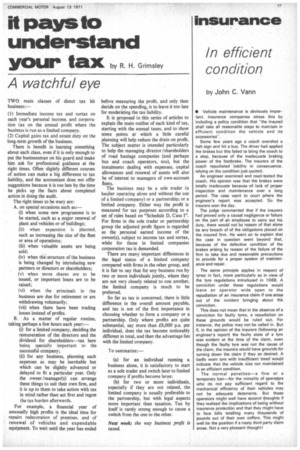Insurance In efficient condition
Page 39

If you've noticed an error in this article please click here to report it so we can fix it.
by John C. Vann • Vehicle maintenance is obviously important. Insurance companies stress this by including a policy condition that -the Insured shall take all reasonable steps to maintain in efficient condition the vehicle and its accessories".
Some few years ago a coach overshot a halt sign and hit a bus. The driver had applied the brakes but this failed to bring the coach to a stop, because of the inadequate braking power of the footbrake. The insurers of the coach repudiated liability in consequence, relying on the condition just quoted.
An engineer examined and road-tested the coach. His opinion was that the brakes were totally inadequate because of lack of proper inspection and maintenance over a long period. The case went to court where the engineers report was accepted. So the insurers won the day.
The judge commented that if the insurers had proved only a causal negligence or failure on the part of an employee to carry out his duty, there would not by reason of that alone be any breach of of the obligations placed on the insured firm. He went on to explain that the case in question went beyond that, because of the defective condition of the brakes arising by reason of the failure of the firm to take due and reasonable precautions to provide for a proper system of maintenance and repair.
The same principle applies in respect of tyres: in fact, more particularly so in view of the tyre regulations introduced in 1968. A conviction under these regulations would leave an operator wide open to the repudiation of an insurance claim if one arose out of the incident bringing about the conviction.
This does not mean that in the absence of a conviction for faulty tyres, a repudiation on these grounds would be ruled out. For instance, the police may not be called in. But if, in the opinion of the insurers (following an engineer's report) the faulty state of a tyre was evident at the time of the claim, even though the faulty tyre was not the cause of the claim, the insurers would have grounds for turning down the claim if they so desired. A badly worn tyre with insufficient tread would indicate that the vehicle was not maintained in an efficient condition.
The normal penalties—a fine or a temporary ban—for the minority of operators who do not pay sufficient regard to the mechanical efficiency of their vehicles may not be adequate deterrents. But those operators might well have second thoughts if they realized the implications of being without insurance protection and that they might have to face bills totalling many thousands of pounds out of their own coffers. This might well be the position if a nasty third party claim arose. Not a very pleasant thought l




















































































